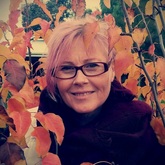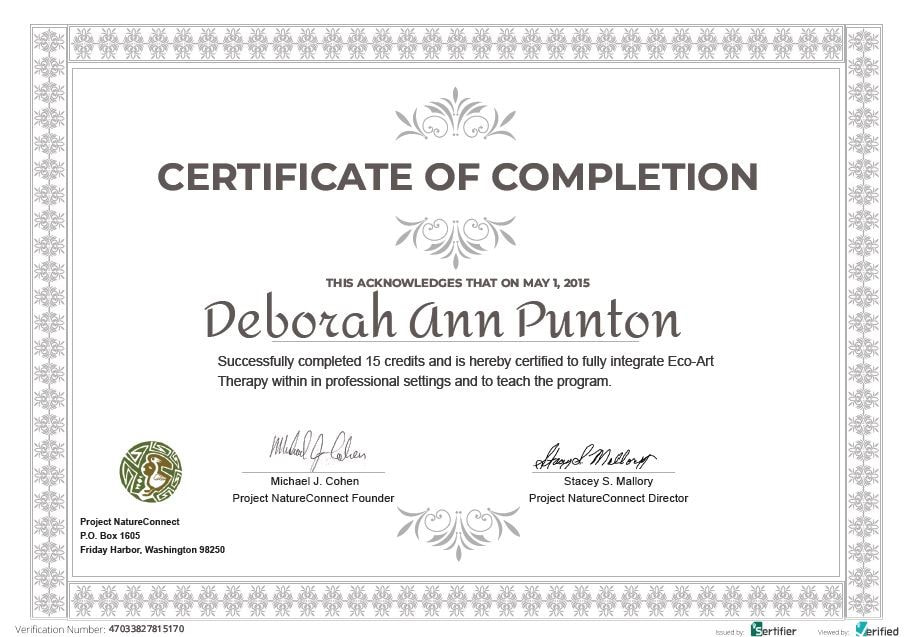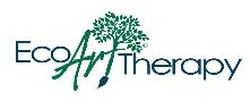
|
Deb began studying, facilitating and mentoring Eco-Art Therapy students in 2012.
Qualifications in Ecopsychology, Eco-Art Therapy and horticulture combine in unique ways to create art, designs, workshops and programs based on connecting to nature and inner nature. Deb learned Traditional Chinese Brushpainting from Chinese-born Master Mr. Lin Lu Zai from 2007-2012. She has exhibited in Singapore and her sold artwork is in Singapore, Asia, Australia and USA. During 2020 COVID she learnt the art of needle-felted Spirit dolls. Artist Bio She created Greensong as an expression of the many facets of applying ecopsychology to enhance our wellbeing and environment. |
What is Eco-Art?
To establish goals and rational of Eco-Art Therapy and Applied Ecopsychology, it is useful to explore the origins of the fields Ecology, Eco-Art and Art Therapy. Eco-Art Therapy combines aspects from amalgamating these disciplines and utilizes aspects as a powerful modality for self-discovery and healing. Eco-Art engages through the sensory world, often sidestepping conditioned patterns of thinking allowing insightful experiences.
Ecology
Ecology refers to the ‘economies’ of living forms, the scientific analysis and study of interactions among organisms and their environment. (Sarkar, 2005) Contemporary ecologies unite many sub-disciplines however, within the context of Ecopsychology and Eco-Art Therapy principle considerations are from the realm of the behavioral aspects, evolutionary ecology, ecosystems and conservation.
Eco-Art
Eco-Artists often have an understanding of ecology and use creative techniques often with consideration to natural materials to create their Eco-Art. Contemporary Eco-Art may reflect the artists’ imaginative interpretation from awareness and responses to Ecological concerns.
Weintraub relates to Eco-Artists as having content enriched by the artistic imagination and license in response to decline of ecosystems, climate change, resource depletion and loss of habitats. (Weintraub, 2012) Eco-Artists can be viewed as environmental activists drawing awareness to current environmental concerns regarding our planet Earth through the medium of creative expression.
Art Therapy
Art Therapy is the use of art expression as a treatment for individuals working through issues such as physical pain and/or psychological trauma. People in such situations may find it easier to express their emotions and unconscious thoughts through non-threatening and nonverbal channels while building a trusting relationship with a trained therapist. Art exercises and materials are chosen for particular goals to assist creative expression, healing and transformation. Often mainstream Art Therapists interpret specifics within the artwork of placement, colour and content subject matter to diagnose aspects of wellbeing and experiences which may contribute to the participants’ problems. -
Natural Attractions
“We are biologically constructed to sense natural attractions.” (Cohen M. J., 1995) Observing psychological distress and increased natural disasters as an attraction, we are called to consider underlying issues. Eco-Art Therapy and Applied Eco-psychology facilitators guide participants to tune in to the multitude of sensory attractions and sense the belonging, balanced, restorative and supportive realm where insight is capable of transformation. Ecotherapies can assist to create greater harmony, balance and stability in people’s lives, leading them to greater insights regarding their sense of place and impact in the web of life.
Eco-Art Therapy and Applied Eco-psychology are a perfect marriage where nature-reconnecting and creating artworks symbiotically work to bring an innate flow of creativity and greater depth to the therapeutic experience. Individual self-discovery and wellbeing from the Eco-Art Therapy model demonstrate transformations which have potential to impact on greater health within community and our environment. Art with EH (Environmental Humanities) and AE (Applied Ecopsychology) can challenge conventional viewpoints and provide an avenue for human engagement by create an emotional response which may provoke a sense of responsibility or obligation leading to a caring environmental action through an evolving sensory experience.
Eco-Art classes and workshops with Greensong offer interactions with the natural environment through exploring sensory connections and manifesting creative expression.
Intentions:
• Explore natural attractions and relationships (Relationships with self, community and environment)
• Creative expression to consolidate the experience and further enhance insights, understanding and wellbeing
• Promote individual and societal health, resilience and ecological awareness
References:
Cohen, M. J. (2003). The Web Of Life Imperative. Victoria, Canada.
Cohen, M. J. (1995). Reconnecting with Nature. Lakeville: Ecopress.
Heginworth, I. S. (2008). Environmental Arts Therapy and The Tree of Life.
Kevin J. Coyle, J. L. (2011). The Psychological Effects of Global Warming on the United States and Why the U.S. Mental Health Care System Is Not Adequately Prepared. National Wildlife Federation.
http://www.nwf.org/pdf/Reports/Psych_Effects_Climate_Change_Full_3_23.pdf
Sweeney, T. (2014) Eco-Art Therapy. Creative Activities That Let Earth Teach
To establish goals and rational of Eco-Art Therapy and Applied Ecopsychology, it is useful to explore the origins of the fields Ecology, Eco-Art and Art Therapy. Eco-Art Therapy combines aspects from amalgamating these disciplines and utilizes aspects as a powerful modality for self-discovery and healing. Eco-Art engages through the sensory world, often sidestepping conditioned patterns of thinking allowing insightful experiences.
Ecology
Ecology refers to the ‘economies’ of living forms, the scientific analysis and study of interactions among organisms and their environment. (Sarkar, 2005) Contemporary ecologies unite many sub-disciplines however, within the context of Ecopsychology and Eco-Art Therapy principle considerations are from the realm of the behavioral aspects, evolutionary ecology, ecosystems and conservation.
Eco-Art
Eco-Artists often have an understanding of ecology and use creative techniques often with consideration to natural materials to create their Eco-Art. Contemporary Eco-Art may reflect the artists’ imaginative interpretation from awareness and responses to Ecological concerns.
Weintraub relates to Eco-Artists as having content enriched by the artistic imagination and license in response to decline of ecosystems, climate change, resource depletion and loss of habitats. (Weintraub, 2012) Eco-Artists can be viewed as environmental activists drawing awareness to current environmental concerns regarding our planet Earth through the medium of creative expression.
Art Therapy
Art Therapy is the use of art expression as a treatment for individuals working through issues such as physical pain and/or psychological trauma. People in such situations may find it easier to express their emotions and unconscious thoughts through non-threatening and nonverbal channels while building a trusting relationship with a trained therapist. Art exercises and materials are chosen for particular goals to assist creative expression, healing and transformation. Often mainstream Art Therapists interpret specifics within the artwork of placement, colour and content subject matter to diagnose aspects of wellbeing and experiences which may contribute to the participants’ problems. -
Natural Attractions
“We are biologically constructed to sense natural attractions.” (Cohen M. J., 1995) Observing psychological distress and increased natural disasters as an attraction, we are called to consider underlying issues. Eco-Art Therapy and Applied Eco-psychology facilitators guide participants to tune in to the multitude of sensory attractions and sense the belonging, balanced, restorative and supportive realm where insight is capable of transformation. Ecotherapies can assist to create greater harmony, balance and stability in people’s lives, leading them to greater insights regarding their sense of place and impact in the web of life.
Eco-Art Therapy and Applied Eco-psychology are a perfect marriage where nature-reconnecting and creating artworks symbiotically work to bring an innate flow of creativity and greater depth to the therapeutic experience. Individual self-discovery and wellbeing from the Eco-Art Therapy model demonstrate transformations which have potential to impact on greater health within community and our environment. Art with EH (Environmental Humanities) and AE (Applied Ecopsychology) can challenge conventional viewpoints and provide an avenue for human engagement by create an emotional response which may provoke a sense of responsibility or obligation leading to a caring environmental action through an evolving sensory experience.
Eco-Art classes and workshops with Greensong offer interactions with the natural environment through exploring sensory connections and manifesting creative expression.
Intentions:
• Explore natural attractions and relationships (Relationships with self, community and environment)
• Creative expression to consolidate the experience and further enhance insights, understanding and wellbeing
• Promote individual and societal health, resilience and ecological awareness
References:
Cohen, M. J. (2003). The Web Of Life Imperative. Victoria, Canada.
Cohen, M. J. (1995). Reconnecting with Nature. Lakeville: Ecopress.
Heginworth, I. S. (2008). Environmental Arts Therapy and The Tree of Life.
Kevin J. Coyle, J. L. (2011). The Psychological Effects of Global Warming on the United States and Why the U.S. Mental Health Care System Is Not Adequately Prepared. National Wildlife Federation.
http://www.nwf.org/pdf/Reports/Psych_Effects_Climate_Change_Full_3_23.pdf
Sweeney, T. (2014) Eco-Art Therapy. Creative Activities That Let Earth Teach
Studying Eco-Art Therapy
Option 1: Individual Courses Only. Duration 12 weeks per course.
ECO 530 An Introduction to Eco-Art Therapy
ECO 531 Advanced Studies in Eco-Art Therapy
Option 2: EcoArt Therapy Certificate. Approximately 1 year. CO 500 (B): Organic Psychology of Global Citizenship + EA Activities
ECO 530: An Introduction to Eco-Art Therapy
ECO 531 Advanced Studies in Eco-Art Therapy
ECO 501: Introduction to Educating, Counseling & Healing with Nature + EA Activities
ECO 800 (NHP): The Hidden Organic Remedy: Nature as a Higher Power
ECO 532: Independent Reading and Research in Eco-Art Therapy
Inquire at Eco-Art Therapy
ECO 530 An Introduction to Eco-Art Therapy
ECO 531 Advanced Studies in Eco-Art Therapy
Option 2: EcoArt Therapy Certificate. Approximately 1 year. CO 500 (B): Organic Psychology of Global Citizenship + EA Activities
ECO 530: An Introduction to Eco-Art Therapy
ECO 531 Advanced Studies in Eco-Art Therapy
ECO 501: Introduction to Educating, Counseling & Healing with Nature + EA Activities
ECO 800 (NHP): The Hidden Organic Remedy: Nature as a Higher Power
ECO 532: Independent Reading and Research in Eco-Art Therapy
Inquire at Eco-Art Therapy




